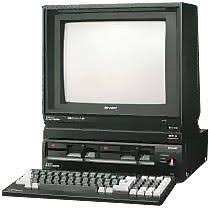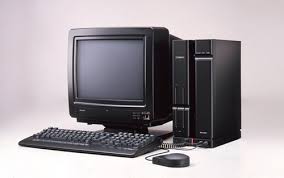In 1982, 4 years after Sharp Corporation entered the microcomputer business with its MZ series of business and personal computers, a seperate department within Sharp, its Television division, decided
it too wanted to enter the market, doing so with the Sharp X1 Series.
The X1 followed along the same design concept as the MZ series, keeping its 'clean design' and in combination with a dedicated display TV, differentiated itself from the MZ series by the uniqueness afforded it by the TV division's products, such as "superimpose" that superimposes the TV screen and the computer screen, channel control from the keyboard, advanced sound and graphics. In many ways the X1 series machines were much more advanced than their MZ siblings.
In 1987 Sharp Television division took a leap into the 16bit world and in so doing brought to an end the 8-bit era. The machine they released, the X68000 was a thoroughbred in everyway. Its power, graphics, audio, storage and looks were simply ahead of the game. The machine architecture in many ways mirrored the most advanced arcade games of the time and a plethora of arcade titles were brought to the platform and many new arcade titles developed on the machine. Over it's lifetime the machine advanced into a full 32bit workstation and is still in use today.
The X1 followed along the same design concept as the MZ series, keeping its 'clean design' and in combination with a dedicated display TV, differentiated itself from the MZ series by the uniqueness afforded it by the TV division's products, such as "superimpose" that superimposes the TV screen and the computer screen, channel control from the keyboard, advanced sound and graphics. In many ways the X1 series machines were much more advanced than their MZ siblings.
In 1987 Sharp Television division took a leap into the 16bit world and in so doing brought to an end the 8-bit era. The machine they released, the X68000 was a thoroughbred in everyway. Its power, graphics, audio, storage and looks were simply ahead of the game. The machine architecture in many ways mirrored the most advanced arcade games of the time and a plethora of arcade titles were brought to the platform and many new arcade titles developed on the machine. Over it's lifetime the machine advanced into a full 32bit workstation and is still in use today.
Various articles are available on these machines, ie Wikipedia X1 and Wikipedia X68000, which the reader is
encouraged to read to gain a basic understanding before perusing this site, if only to understand basic machine configuration and jargon.
My link to these machines was when I lived in Japan in the early 90's. I would often walk around Akihabara drooling over the Super MZ, X1 Turbo and X68000, wanting to own them but cost
and documentation, being soley in Kanji/Hiragana/Katakana, meant I could only dream of what my Japanese compatriots were able to enjoy.
Fast forward to the future and with the aid of advancements such as Google Translate, the dream now becomes reality. I have successfully purchased and restored a Sharp X1 Turbo II and currently renovating an X68000 Expert HD.
I have many ideas for projects with these machines and like the MZ series, aim to keep the machines alive, for re-use of old software, learning, sentimental reasons and history.
Please click on a link to the left which will be updated when projects commence.
Fast forward to the future and with the aid of advancements such as Google Translate, the dream now becomes reality. I have successfully purchased and restored a Sharp X1 Turbo II and currently renovating an X68000 Expert HD.
I have many ideas for projects with these machines and like the MZ series, aim to keep the machines alive, for re-use of old software, learning, sentimental reasons and history.
Please click on a link to the left which will be updated when projects commence.





